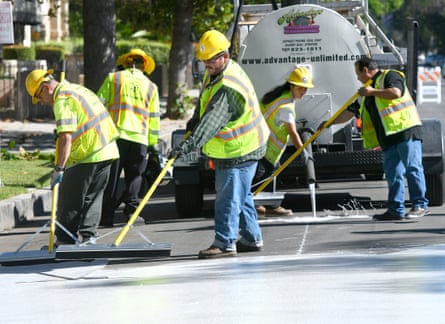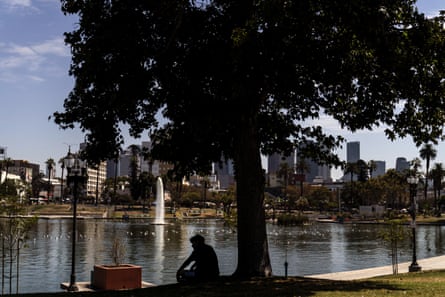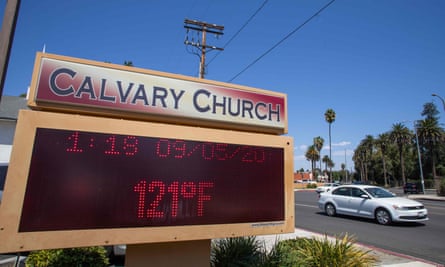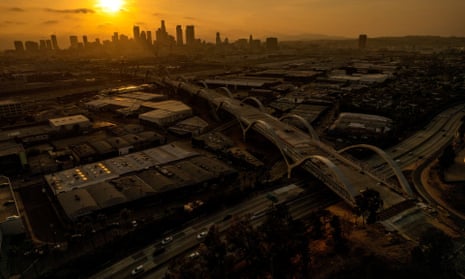It may look like a normal roof, but the top of Martin Luther King Jr hospital near the Los Angeles neighborhood of Watts gleams in the light. The roof isn’t made from a typical material: instead of absorbing heat, its paint-like coating reflects the sun’s energy upward. That benefits anyone working inside the building, officials say, as it cools and makes the interior more comfortable – as well as lowering energy bills.
This type of roofing design comes at an urgent time for America’s second-largest city. In Los Angeles, long romanticized for its year-round sunshine and Mediterranean climate, heat is a slow-moving disaster. In 2022, the city grappled with a record-breaking September heatwave that brought days of triple-digit temperatures. A UCLA study predicts that by 2050 the number of days with temperatures of 95F (35C) or hotter will reach 22 a year – more than double the number that the Los Angeles region sees now.
In a city where tree shade is unequally distributed and half the surfaces are dark asphalt or concrete, the solution to increasing temperatures could lie in design.
Los Angeles has the worst “urban heat island effect” – a phenomenon in which cities trap and retain heat due to their high concentration of buildings, roads and other developments – of any city in California. And the burden of extreme heat often falls unequally on the populace – a recent county assessment found that Latinos comprise 50% of Los Angeles’ population, but make up 67% of the population in communities with high vulnerability to extreme heat.
Design changes that could help the city absorb less heat are under way. These include installing cool roofs, coating streets with reflective materials (known as “cool pavement”) and increasing shade by planting more trees.

Nearly a decade ago, the LA mayor’s office convened an advisory panel of scientists. Led by researcher George Ban-Weiss from the University of Southern California (USC), the panel created a computer model of the city’s neighborhoods and microclimates, which allowed it to recommend where cool roofs and pavements and shady trees could be added most effectively. Since then, the city and county have coated more than 150 lane-miles of city streets with cool pavement.
Craig Shaw, who manages the Cool Streets program, part of LA’s Green New Deal that was launched in 2019, says cool pavement was first used in Los Angeles in 2015, with an installation at Balboa Park. He says individual streets can be cooled by 10-12 degrees fahrenheit after the reflective coating is applied. “It’s been very effective for us,” he says.
The city has converted 5.3m sq ft of pavement in 2022 alone – about 92 lane-miles – in the hottest areas of the city. There’s also a focus on newly paved streets, Shaw says, with the expectation that the reflective coating will last as long as traditional asphalt: 20-30 years. A monthly temperature reading from the city’s general services division collects data on how much cooler the treated streets are than nearby untreated streets. In one test, the cool pavement was measured to be 25 degrees cooler than nearby untreated asphalt.
Cool roofs, cool pavement – and natural shade makers too
Ban-Weiss, the USC scientist who served on the taskforce to study urban heat in Los Angeles in 2017, died last year. Some of his former students continue to untangle the science of heat in Los Angeles.
Joseph Ko, a doctoral candidate at USC, recently published a study about a cool pavement project in Covina, California. He says his research shows that cool pavements lowered air temperatures by 0.2C, but the solution isn’t without flaws. The coating used in cool pavement increased reflected shortwave radiation, he says, which could make people uncomfortable – imagine standing on a really shiny surface and getting pummeled with sunlight reflecting off the ground.
And for cool pavement to have a notable impact on air temperature, it will have to be employed much more widely. “The pilot projects are an interesting opportunity to study the real world impact on a smaller scale before we kind of rush into it and implement it across the whole LA basin,” he says.

Alongside transforming pavements, the Cool Streets program is also planting trees – 2,000 so far – which Shaw, the program’s manager, says help keep the temperatures down.
Trees seem like an uncontroversial choice: they provide shade and can cool the nearby area by more than 20 degrees fahrenheit by means of evapotranspiration – the process of transferring water from the ground into the air through plants – according to the Environmental Protection Agency. Researchers have been working to pinpoint the areas most in need of trees in Los Angeles, particularly dense areas with lots of concrete and few parks.
But planting trees isn’t a panacea, says Hannah Schlaerth, a doctoral student at USC who studies urban greening. That’s because trees can, counterintuitively, complicate urban heat mitigation in several ways. For example, trees emit volatile organic compounds (VOCs), organic chemicals that turn into vapor easily (the smell of pine is one example). In the presence of sunlight, these compounds can form ozone – paradoxically worsening air pollution, especially from certain species (palm trees emit a large amount of VOCs, while elms and oaks do not). Trees also block wind from carrying away pollutants. “Think of the wind blowing through a canyon and then in a place where there are a lot of elements in the way,” explains Schlaerth.
Plant greenery also absorbs more heat than bare soil, which can increase temperatures above the tree canopy – Schlaerth found that with a 50% increase in greenery, there is higher daytime warming above the canopy and reduced cooling at night.

Not that Schlaerth discounts the importance of trees in the temperature management of cities – but more research needs to be done, she says, adding that she has met with Los Angeles urban planners who were receptive to her work.
Cool roofs, though, have been scientifically shown to be effective in alleviating heat. The Los Angeles city council unanimously approved a cool roof requirement for residential buildings that took effect in 2015, requiring homeowners and landlords installing new roofs to use light-colored materials such as shingles, tiles, spray-on coatings and membranes with a “cool roof rating”, for which the city provides rebates.
Ko, from USC, is also researching another topic: the heat produced by cars in traffic, bodies on streets and pipes in buildings. “That’s actually one major contribution to the urban heat island that sometimes people often aren’t aware about – because it’s not something that you can see.”
For example, studies of Tokyo have shown that across that city, anthropogenic heat alone could increase the citywide average temperature by one to two degrees celsius, Ko says. “So in certain hotspots, anthropogenic heat” – heat from a running car engine, or the blast from an exhaust pipe at the back of a building – “can increase their temperature by even more – and you can feel that.”
Ko hopes his research can help other urban areas – like the megacities emerging in Africa and India – avoid falling into design traps that more developed cities are now trying to fix. “Here, it’s kind of hard to do it retroactively,” he says. “But if you’re developing it’s easier to implement while you’re growing.”
The path for Los Angeles as temperatures increase remains long but crucial. “We’re going to continue on developing new and better strategies to combat climate change and the heating of our city,” says Shaw. “So this is the first step … We will continue the program as long as the heat continues to rise.”

Comments (…)
Sign in or create your Guardian account to join the discussion